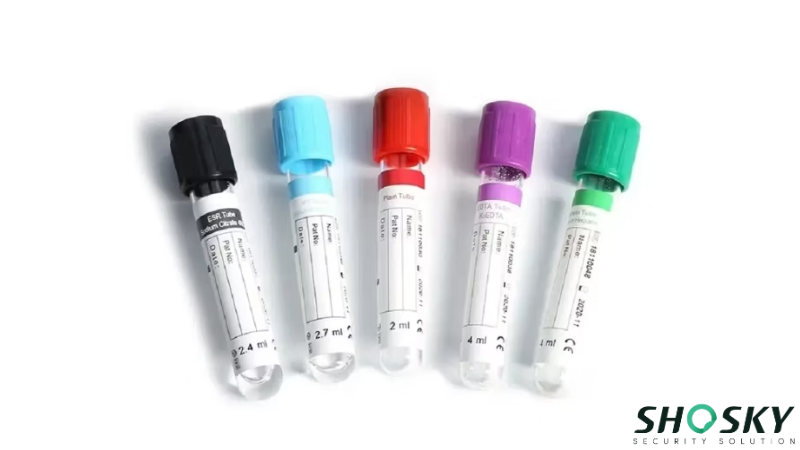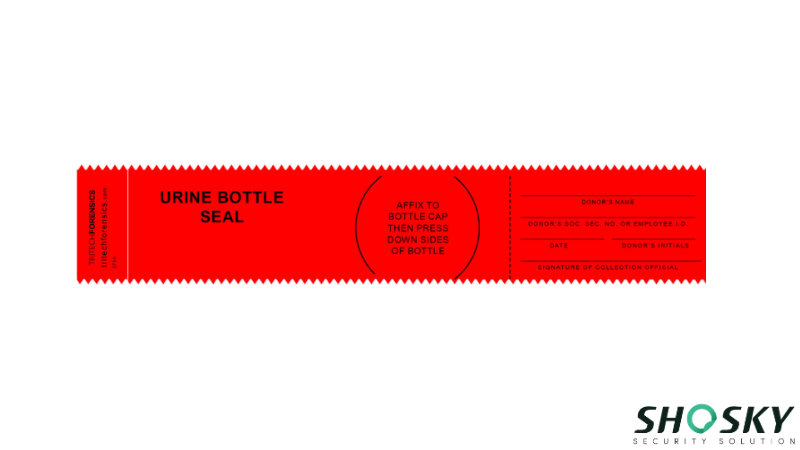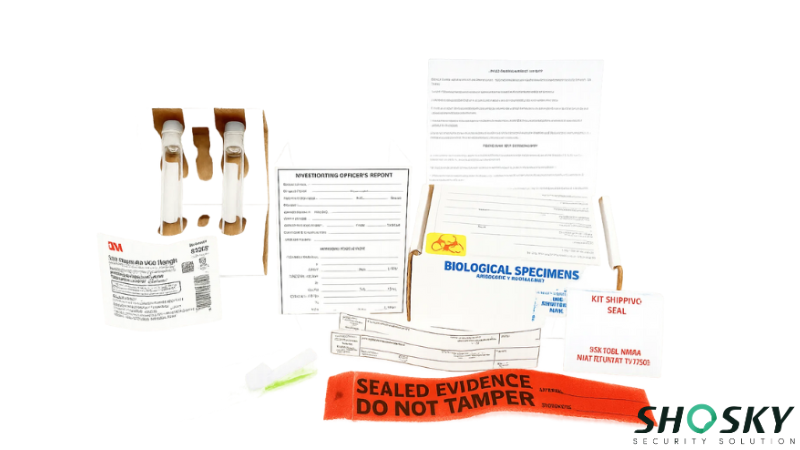In clinical and research labs, even small specimen errors can have large consequences. A study published in the National Institutes of Health (NIH) found that over 60% of lab errors happen before analysis, often due to specimen mishandling. Errors at this stage can affect diagnoses, legal cases, and large-scale studies.
That’s why standards like HIPAA, ISO 15189, and forensic evidence guidelines require strict control over how samples are stored, transported, and accessed. And specimen security seals play a direct role in meeting these compliance demands as well. In this article, we’ll explain what specimen security seals are, how they work, and their main applications across various industries.
What Is a Specimen Security Seal?

A specimen security seal is a specialized security seal designed to protect biological, forensic, or research samples from tampering or substitution. Its core function is to provide visible evidence of any unauthorized attempt to open, break, or replace a specimen container.
Unlike general tamper-evident security seals used in packaging or logistics, specimen seals are designed for stricter compliance needs. They often carry serialization, barcodes, or imprint strips that can be easily written on with ballpoint pens to note the date, quantity, or sample ID—making them directly useful in audits or investigations.
These seals are typically constructed from specialized materials like frangible vinyl, destructible paper, or high-bond adhesives that cannot be removed intact. The materials are chosen specifically to leave clear evidence of tampering – whether through tearing, leaving adhesive residue, or revealing hidden “VOID” messages when disturbed.
How Specimen Seals Work for Tamper-Evident Security?
Specimen seals protect containers by showing visible signs when pulled or removed. Once applied, they can’t be reapplied without leaving marks, making any tampering attempt immediately noticeable. Here are the main ways they keep specimens safe and traceable:

| Feature | How It Protects |
|---|---|
| Tamper-Evident Design | Breaks, leaves residue, or displays a VOID message if disturbed |
| Unique Serial Numbers/Barcodes | Links each specimen to custody records for full traceability |
| Strong Adhesive/Locking System | Holds firmly so seals can’t be replaced without detection |
| Writable Surfaces | IDs, dates, and handler names can be easily written for quick tracking |
These combined features decrease the chances of unnoticed interference and maintain chain-of-custody integrity across clinical, forensic, and research settings.
Types of Specimen Security Seals
There are several types of specimen security seals, each engineered to match different sample handling needs. From securing small vials to sealing larger transport bags, these options provide tamper-evident protection and help maintain specimen integrity throughout the chain of custody.
Here are the main types of specimen security seals:
- Adhesive seals for containers and vials – made from frangible paper or film, designed to tear if removed.
- Bag and pouch seals – durable plastic closures that protect larger or multiple samples.
- Tamper-evident tapes – security tape with printed warnings that provide a quick view of tampering attempts.
- Custom seals with logos or color coding – help facilities track samples, maintain the chain of custody, and reduce substitution risks.

Selecting the right seal depends on the application. Adhesive labels work best for small vials, while bag seals are more practical for transporting groups of samples. Custom color-coded options give labs an economical way to improve tracking, save time during audits, and support compliance with ISO and forensic standards.
Applications of Security Seals in Different Industries
Security seals support a wide range of industries where specimen protection is critical. From chain of custody in legal cases to biobanking and pharmaceutical manufacturing, they prevent tampering, contamination, and any attempt to decrease the quantity of valuable samples. Let’s see their applications in detail:
1. Security Seals in Chain of Custody
Chain of custody protocols are fundamental to maintaining specimen integrity in legal, forensic, and regulatory contexts. Specimen security seals serve as the physical barrier between authorized handling and potential tampering, creating an unbroken record of sample custody.

Here are a few uses of security seals in the chain of custody:
- Criminal investigations – Protect DNA, drug, and trace evidence
- Civil litigation – Secure medical, product, and documentary samples
- Regulatory inspections – Maintain sample integrity for FDA, EPA, or OSHA audits
- Internal investigations – Document workplace incidents or quality issues
- Insurance claims – Preserve evidence for accident or fraud cases
When a seal is broken, labs must treat the sample as compromised. In scenarios like forensic testing, a broken specimen seal can invalidate results—eliminating legal admissibility and highlighting the importance of tamper-evident security.
2. Security Seals in Laboratory Sealing Solutions
Specimen misidentification and contamination happen more often than you’d think. Up to 0.93% of biopsies may be affected by provenance complications, like mix-ups or foreign tissue. So, labs rely on these integrity seals to uphold scientific validity and institutional compliance. They support audit trails, streamline tracking, and minimize sample mix-ups.

Security seals applications in laboratory sealing solutions include:
- Clinical samples – Secure clinical samples (blood, urine, tissue)
- Pathology specimens – Protect tissue and surgical samples
- Microbiology cultures – Prevent contamination of bacterial, viral, and fungal samples
- Genetic testing – Safeguard DNA for disease screening and pharmacogenomics
- Drug testing – Maintain chain of custody for employment, sports, and legal tests
- Clinical trials – Protect experimental drugs and patient biomarkers
Different lab environments require varied sealing methods to maintain sample integrity across clinical, forensic, and research contexts. In clinical settings, adhesive seals on blood, urine, or tissue vials—written on with ballpoint pens—prevent unwanted tampering and preserve the quantity and identity of the sample.
3. Security Seals in Environmental & Agricultural Testing
Environmental and agricultural samples need sealing solutions that prevent contamination and protect the chain of custody. Field investigators often affix EPA-style custody seals and document collection details directly on them.

Security seals applications in environmental & agricultural testing include:
- Water testing – Secure groundwater, surface, and drinking water samples
- Soil studies – Protect samples from industrial and agricultural sites
- Air quality – Safeguard atmospheric and particulate samples
- Food safety – Maintain the integrity of crops, livestock, and processed foods
- Wildlife research – Protect biological samples from endangered species
- Climate studies – Secure ice cores, sediments, and gas samples
These measures reduce the risks of sample compromise. When done correctly, investigators can confidently show regulators or auditors that samples arrived securely and untampered.
4. Security Seals in Pharmaceutical & Biotech Research
Research and development facilities work with highly valuable compounds and proprietary formulations that require maximum security protection. A single compromised sample can represent millions of dollars in lost research investment.

Security seals applications in pharmaceutical & biotech research include:
- Drug development – Protect experimental compounds
- Quality control – Secure raw materials and finished products
- Biomarker research – Safeguard patient samples for personalized medicine
- Vaccine production – Maintain sterility and traceability
- Regulatory submissions – Supporting GMP compliance by maintaining clear chain-of-custody records
- IP protection – Prevent unauthorized access to compounds
By combining tamper-evident security with unique identifiers, pharmaceutical facilities reduce the risk of counterfeit medicines and protect patients by guaranteeing product authenticity.
5. Security Seals in Biobanking and Long-Term Storage
Biobanks store millions of specimens for future research, requiring security measures that perform reliably over years or decades. These facilities manage irreplaceable samples that represent significant scientific and financial value.

Security seals applications in biobanking and long-term storage include:
- Genetic repositories – Protecting DNA, RNA, and protein samples for longitudinal studies
- Tissue banks – Securing frozen sections, paraffin blocks, and fresh specimens
- Plasma and serum storage – Maintaining sample integrity in ultra-low temperature freezers
- Stem cell banking – Protecting valuable cell lines and regenerative medicine materials
- Population studies – Safeguarding samples from large-scale epidemiological research
- Rare disease research – Securing limited specimens from patients with uncommon conditions
These measures give researchers confidence that every specimen remains intact, supports ISO 20387 compliance, and maintains integrity for studies that may span decades.
Best Practices for Using Specimen Security Seals

Specimen security seals need to be applied carefully to work as intended. Containers should be closed securely before the seal is placed, with enough pressure to prevent anyone from being able to pull it off without damage. Recording seal information is just as important as applying it.
Each seal carries a unique identifier such as a serial number, barcode, or imprint strip. These details should be logged immediately in either a custody record book or a digital tracking system, along with the sample ID, date, and handler’s name. This creates a reliable record that links the specimen to its integrity seal and prevents unnoticed substitution.
Training is equally important. Training staff to recognize tamper signs keeps the system reliable. Staff should know how to check for tamper signs like void messages, broken seals, or mismatched numbers.
Regular instruction ensures that inspections are consistent and accurate. This helps facilities stay compliant with HIPAA, ISO, and forensic standards while maintaining sample integrity.
FAQs
Are specimen seals reusable?
No, specimen seals are designed for single use. Once broken, they show evidence of tampering and cannot be reapplied.
Are integrity seals required for all specimen shipments?
Yes, most clinical, forensic, and regulatory bodies require integrity seals to maintain the chain of custody and protect sample validity.
Can I get seals customized for my laboratory?
Yes, security seals can be customized with serial numbers, barcodes, colors, or writable surfaces to fit your lab’s tracking system.
Conclusion
Specimen security seals are an important tamper-evident solution that provides reliable protection against tampering and helps maintain the integrity of valuable samples. Their design allows easy tracking and documentation. So, proper use of these seals ensures secure, accurate, and compliant specimen handling.
Get Reliable Specimen Security Seals from Shosky Security
When it comes to protecting valuable samples, Shosky Security offers high-quality specimen security seals. Our seals are engineered to maintain sample integrity across laboratories, research facilities, pharmaceutical production, and more. Contact us to get an instant quote or sample.

